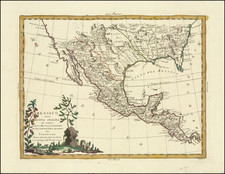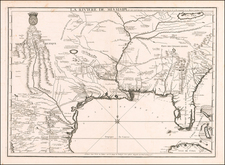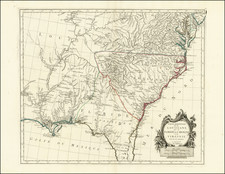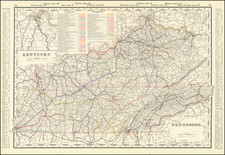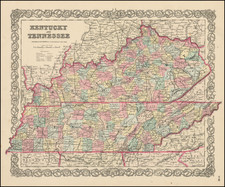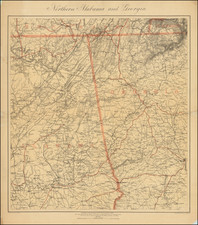One of the Earliest Geological Maps of the South -- Gold & Titanium Mining in Georgia, Eastern Tennessee and Western North Carolina!
One of the first geological maps of the south, filled with notations locating gold and gem deposits, including even a note identifying a Titanium region in the Unaka or Smoky Mountains.
The map shows fascinating details of the Cherokees Nation with its capital at New Echota subdivided for mining and development. In north Georgia GOLD is marked in 15 places. Tennessee shows lead, coal and iron ore, titanium and "GOLD FOUND THROUGHOUT" in the Smokey Mountains. Marble, zinc and slate for roofing were also found in Tennessee.
Gold continues to be found as far east as Burke Co. North Carolina. Geological areas are marked "primitive," "secondary," and "transitional". During the Appalachian gold rush period, so much gold was found that mints were established in both North Carolina and at Dahlonega, Georgia.
An engraved inset of the Smoky Mountains is captioned "Characteristic view of the Mountains and the Tennessee River above Smoky Mountain; Macon County North Carolina." A vignette shows a small pot found 15 feet underground whose composition of copper and tin with a trace of iron "proves its antiquity."
The southeastern boundary of the map is the Chattahoochee River, including a section of the Cherokee Boundary, with the southern part of the map only a few miles from suburban Atlanta.
The map appeared in Peck's article, Geological and Mineralogical Account of the Mining Districts in the State of Georgia, published in the American Journal of Science and Arts, Vol. XXIII (1933).
Gold Mining In Georgia, etc.
Gold was first "discovered" in Georgia in 1828, although the earliest accounts of the gold in the region date back to the end of the 16th Century. There are several legends that describe the first strike in 1828. The Georgia gold rush began in 1829 in Lumpkin County. The Macon Telegraph reported that in "the winter of 1829 and 30, when the precious metals having been discovered in great abundance upon our Cherokee soil, great numbers of people from Georgia and other States rushed to the Territory in search of its treasures."
Gold was discovered in the Cherokee lands of Carroll County, Georgia, in 1830, but quickly spread throughout the region. While technically Indian lands, mining operations quickly sprang up in Lumpkin, White, Union, and Cherokee counties. Most of the early mining was placer mining. By 1830, Nile's Register estimated that there were 4,000 miners working on Yahoola Creek alone.
The mass arrival of prospectors and settlers caused significant problems with the Cherokee increased, a significant factor in the forced exodus of Indigenous people, later known as the Trail of Tears. President Andrew Jackson authorized the Indian Removal Act in 1830, which would allow a takeover of the gold mining areas among other places.
The state of Georgia held the Gold Lottery of 1832 and awarded land previously owned by the Cherokee, to the winners in 40-acre tracts. By the 1840s gold mining saw a sharp decline.









